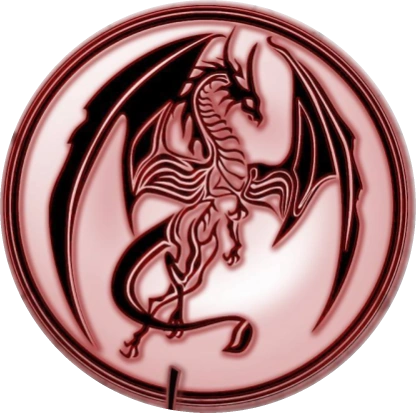The Chinese word for dragon is Lóng (traditional ch. 龍, simplified 龙, or Lung). Dragons of Chinese mythology have the body of a snake, the mane of a lion, antlers and four legs. The Lóng are water dragons that appear often in Chinese mythology. Although they are generally considered good creatures as opposed to Western Dragons , they should be viewed as neutral beings or living forces of nature that can bring destruction when enraged.
Description[]
A young Lóng has a head similar to that of a carp, while the head of an adult Lóng has is commonly portrayed with the head of a camel with antlers on it. A noticeable aspect of its face is the barbels, an important organ that allows balance and orientation in the air and against wind currents. Compared to Western dragons, with the exception of the Fucan Lóng, the Lóng does not hoard treasure.
The ancient Chinese philosopher Wang Fu described nine basic properties of the dragon. It possesses the:
- horns of a deer
- head of a camel
- ears of a cow
- eyes of a demon
- neck of a snake
- stomach of a clam
- scales of a carp
- claws of an eagle, and
- paws of a tiger.
There are other similar descriptions to the characteristics of a Chinese dragon. One of them describes it to have one feature of each animal of the Chinese horoscope.
According to the 19-century writer/mythology analyst Charles Gould, the bones of male dragons are thicker and have finer lines as compared to female dragon bones. Yet, the so-called "dragon bones" used in traditional Chinese medicine are usually the bones of extinct mammals.
Behavior[]
Normally the Lóng are known to be kind to humans, but when their anger is incited, they tend to punish people with natural disasters, or bring about drought by their absence. To avoid this, the ancient Chinese people offered sacrifices to them. According to Gould, a sparrow would be fitting sacrifice to call for rain, as sparrows are a favorite food of dragons.
To ward off dragons, one can use metal or mong-plants (presumably Mung beans), as it hates both these things. Offerings made with warding off in mind include five-coloured silk and the Pride of India, which the dragon dislikes. Pride of India is a common name of various plants, which are the Koelreuteria paniculata, Lagerstroemia speciosa and Melia azedarach.
Gould quotes many sources that record that dragons can "shed" their mortal bodies. This is why, according to Shi Chăn and Tsung Shih, one cannot confirm the death of a dragon through the discovery of its bones; the dragon may have just left its physical body behind. In ancient Chinese literature, it is disputable whether a dragon can die at all.[2] Other accounts of dragons in ancient/medieval Chinese literature and folklore depict dragons as being able to shapeshift into animals and humanoid forms.
Symbolism[]
In both ancient and modern China, the dragon is considered an important symbol. It represents, among other things the principle of Yang, while its counterpart, the Fenghuang (Chinese phoenix), embodies the Yin. It is believed that 81 of its scales are of the Yang essence, but only 36 contain the essence of Yin. Chinese dragons are often considered to be living embodiment of the forces of nature, especially relating to water.
The Azure Dragon is one of the Four Symbols/Holy Creatures of the Chinese constellations/mythology, representing the wood element, the eastern cardinal direction and the season of spring. Some interpretations also consider the Yellow Dragon as a symbol of the element of metal, and the cardinal Fifth Direction (the centre).
The Emperor of China used the dragon as a symbol of his own power. Even in modern parlance, people with outstanding personalities are still referred to as being like dragons.
Classification[]
Chinese mythology classifies dragons into many different types. The types are:
- Huáng Lóng: The Yellow Dragon, the first of all dragons.
- Tiānlóng: Divine sky dragons that live with the gods.
- Shén Lóng: A spirit dragon that controls the weather.
- Dìlóng: An earth dragon that lives underground.
- Fúcánglóng: Underground guardians of hidden treasures and places of powerful energy.
- Nie Lóng: An evil dragon that brings destruction.
- Jiāolóng: Crocodile dragon that can change form.
- Pánlóng: Snake-like river dragons.
- Fēilóng and Ying Long: Winged sky dragons.
- Qīng Lóng: The Azure Dragon of the Four Symbols/Holy Creatures symbolising the East.
- Lóng Wáng, Dragon Kings who rule over the waters.
Number of claws[]
In classifying the Lóng, the number of claws on each leg is important. A five-toed dragon symbolises the Emperor, whereas four- and three-toed dragons symbolise the common folk. The claw count can also indicate its origin, as Chinese dragons have five toes, Korean dragons have four toes and Japanese dragons, three.
Reproduction and growth[]
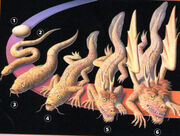
The life cycle of a Chinese Lóng: egg (1), water snake (2), Kiao (3), Lang (4), Kioh-Lóng (5), Ying-Lóng (6)
In Asia, dragons are often depicted with a pearl. Many consider this to be the egg of its young. In reality, its eggs should not be much larger than chicken eggs and have the appearance of river pebbles.
Mythology dictates that it can take up to 1,000 years before the egg hatches into a dragon, and yet another 500 years for it to grow into a Kiao. This form resembles a snake with a carp's head(compare: Liyu tiao longmen). Another 1,000 years muss pass for it to form a beard, scales and legs, and then another 500 for a set of horns. This new form is called Qiu Lóng (虯龍) and has the ability to hear unlike the previous forms. After another 1,000 years the animal becomes an adult Ying Lóng (應龍), which has wings according to some sources.[3]
These numbers appear to be vastly exaggerated, which may be due to the divine nature of dragons in mythology.
History[]
Origin[]
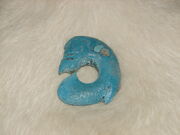
Pig dragon amulet
The oldest known dragon statue from China dates back to the 5th millennium BC and is associated with the Yangshao culture. Other early depictions of dragons include the "pig dragon" and a dragon shape formed from shells of the Hongshan culture. The latter is dated 4700-2900 BC.[4]
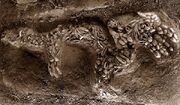
Dragon formed from shells from the Henan province.
Next to snakes and crocodiles, fossils seem to be an inspiration for the depiction of dragons, reflected today in Chinese folk medicine. Some dinosaurs found in China were also named after dragons, for example the Mei long and the Dilong paradoxus.
Another theory for the origin of the dragon is the association with weather. According to it, Lóng may have been a word for tornadoes. Although tornadoes no longer occur in China due to climate change, the term may have developed into the mythological being known as Lóng.[5]
These were the foundations on which the creature known as Lóng developed. Over time more and more supernatural abilities were given to the dragon, for example it could shrink to the size of a silkworm or expand as big as the universe itself, control the rain and fly without needing wings.
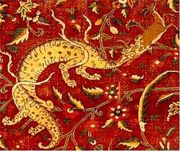
Depiction of the persion dragon Azhi Dahaka as an eastern dragon.
The two earliest emperors of China, the Yellow Emperor Huangdi and the Emperor Yan, were associated with dragons. The mythological being thus became a symbol of the imperial crown, where the imperial dragon had different colours depending on the dynasty. The Emperor naturally traced his lineage to divine dragons.
Other types of Eastern dragons, such as the Japanese or Korean dragons, are based on or heavily influenced by the Chinese Lóng. Medieval European travellers probably found the Lóng of Chinese mythology synonymous with the dragons of European myths, while the Persian and Arabian dragons seem to be influenced equally from Chinese and European sources.
Modern Times[]
In contrast to Western countries, in which only a few still believe in the existence of dragons, there are still regular dragon sightings in China.
On top of that, some Chinese markets today sell "dragon bones" as a form of traditional medicine. These are often fossils of other animals such as dinosaurs.
The veneration of dragons is still very popular in some places, especially in rural areas. This includes the releasing of flying dragons made of wood, bamboo and silk. It is believed that by releasing the kite string misfortune or illness will be dispelled. Consequently, if one picks up the lost dragon of another, he will receive ill luck. In rural China, rituals involving praying for rain to come are still practiced, with a dragon king usually being worshipped as the main deity of rain as part of the prayer.[6]
The Chinese dragon lives on in worldwide popular culture in the form of anime characters, manga and video games. One of the most modern Lóng dragons is Shenlong from the Japanese Dragonball manga/anime series.
The Chinese Water Dragon is the namesake for a species of lizard (Physignathus cocincinus).
Gallery[]
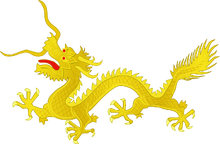
Sources[]

|
This article has been translated from German by Brandon_Pow from the Language Brigade Wiki. The original article can be found through the Interlanguage-Link at the bottom of the page. |
- ↑ Marinus Willem de Visser (1913), The Dragon in China and Japan, Cosimo Classics (2008), ISBN 978-1605204093
- ↑ Charles Gould (1886), Mythical Monsters
- ↑ Andrea Dee, Angelika Gredenberg (2000), Das große Buch der Ungeheuer - Mit über hundert Fabelwesen aus allen Erdteilen, Tosa, ISBN 978-3854922254
- ↑ Mythology StackExchange: What is the earliest known dragon myth
- ↑ Mythology StackExchange: Did the dragons of Chinese mythology originate from tornadoes?
- ↑ Lihui Yang, Deming An, Jessica Anderson Turner (2005) Handbook of Chinese Mythology Oxford University Press
